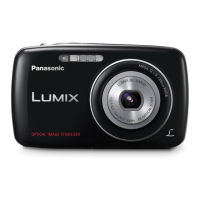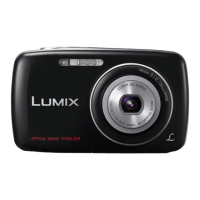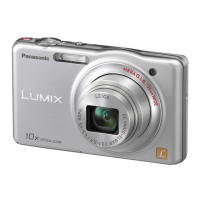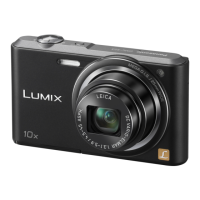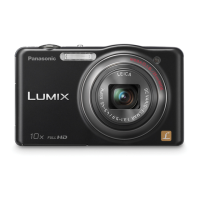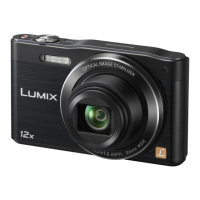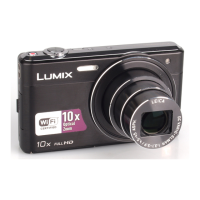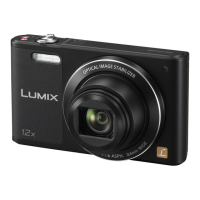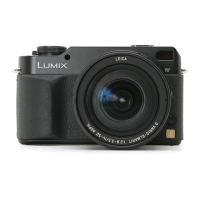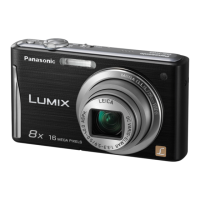
Do you have a question about the Panasonic Lumix DMC-S2 and is the answer not in the manual?
| Megapixel | 14.1 MP |
|---|---|
| Camera type | Compact camera |
| Sensor type | CCD |
| Image stabilizer | Yes |
| Total megapixels | 14.5 MP |
| Image sensor size | 1/2.33 \ |
| Image formats supported | JPG |
| Supported aspect ratios | 3:2, 4:3, 16:9 |
| Maximum image resolution | 4320 x 3240 pixels |
| Still image resolution(s) | 640 x 480, 2048 x 1536, 3232 x 3232, 3648 x 2736, 4320 x 2432, 4320 x 2880, 4320 x 3240 |
| Optical zoom | 4 x |
| Extra/Smart zoom | 8 x |
| Focal length range | 5 - 20 mm |
| Maximum aperture number | 6.5 |
| Minimum aperture number | 3.1 |
| Number of aspheric elements | 8 |
| Lens structure (elements/groups) | 6/5 |
| Maximum focal length (35mm film equiv) | 132 mm |
| Minimum focal length (35mm film equiv) | 28 mm |
| Focus adjustment | Auto |
| Auto Focus (AF) points | 23 |
| Auto focusing (AF) modes | Multi Point Auto Focus, Single Auto Focus |
| Closest focusing distance | 0.05 m |
| ISO sensitivity | 100, 200, 400, 800, 1600, 6400 |
| ISO sensitivity (max) | 1600 |
| ISO sensitivity (min) | 100 |
| Light exposure correction | ± 2EV (1/3EV step) |
| Fastest camera shutter speed | 1/1600 s |
| Slowest camera shutter speed | 8 s |
| Flash modes | Forced off, Forced on, Red-eye reduction, Slow synchronization, Soft |
| Flash range (tele) | 1 - 1.6 m |
| Flash range (wide) | 0.4 - 3.3 m |
| Power source type | Battery, USB |
| Optical viewfinder | No |
| Scene modes | Children, Night portrait, Panorama, Portrait, Sports, Sunset |
| Image editing | Resizing |
| Photo effects | Black&White, Sepia, Vivid |
| White balance | Auto, Cloudy, Daylight, Incandescent, Shade |
| Camera playback | Single image, Slide show, Thumbnails |
| Self-timer delay | 2, 10 s |
| Camera file system | DCF 2.0, Exif 2.3 |
| Video resolutions | 320 x 240, 640 x 480, 1280 x 720 pixels |
| Motion JPEG frame rate | 30 fps |
| Video formats supported | M-JPEG |
| Maximum video resolution | 1280 x 720 pixels |
| Analog signal format system | NTSC |
| Audio system | Mono |
| Memory slots | 1 |
| Internal memory | 70 MB |
| Compatible memory cards | SD, SDHC, SDXC |
| Field of view | 100 % |
| Display diagonal | 2.7 \ |
| Display resolution (numeric) | 230000 pixels |
| USB version | 2.0 |
| Product color | White |
| Cables included | USB |
| Bundled software | PHOTOfunSTUDIO 8.0 Adobe Reader |
| Battery voltage | 3.6 V |
| Battery life (CIPA standard) | 280 shots |
| Depth | 20.6 mm |
|---|---|
| Width | 97.9 mm |
| Height | 56.6 mm |
| Weight | 95 g |
| Weight (including battery) | 112 g |
Guidelines for safely handling the camera to prevent damage and dealing with condensation.
Test shots, copyright, and reference to cautions.
List of items typically included and available for purchase.
Identification and description of the camera's external controls and components.
Explanation of the directional buttons and their specific functions.
Instructions on how to charge the camera's battery.
Information on expected battery life and picture capacity.
Step-by-step guide for inserting and removing memory cards and batteries.
Instructions for removing the battery and memory card from the camera.
Explanation of where images are saved and details on compatible memory cards.
How to check the remaining battery charge and memory space.
Estimates for picture count and recording duration based on card size.
Step-by-step guide to setting the camera's date and time.
Instructions for modifying the existing date and time settings.
An overview of the basic steps for operating the camera.
Explanation of different recording modes available on the camera.
Recommended grip, handling techniques, and using the zoom function.
How to take photos and enter playback mode to view recorded images.
Details on different modes for viewing pictures and videos.
Navigating through recorded images for playback.
Mode overview and basic steps for shooting in Intelligent Auto mode.
How the camera identifies scenes and uses flash automatically.
Using the 'Happy' color mode for vivid pictures.
Important notes regarding settings available in Intelligent Auto mode.
Steps for recording video clips, including start and end.
How to view still images in the standard playback mode and navigate.
How to play back recorded video clips and their operations.
How to magnify images during playback.
Displaying multiple images simultaneously for selection.
Viewing images organized by date using a calendar interface.
Procedure for deleting a single displayed image.
Options for deleting multiple pictures or all pictures.
General guide to navigating and operating the camera menus.
Explanation of the different types of menus available (Rec, Setup, Playback).
Setting the camera's date, time, and world time destinations.
How to adjust the clock for daylight saving time.
Adjusting beep sounds, volume, and LCD display brightness/color.
Settings for focus icon, auto power off, and auto picture review.
Resetting camera settings to their default values.
Adjusting video output and automatic rotation of portrait images.
Checking the camera's firmware version.
Formatting the built-in memory or memory card.
Changing language and viewing feature demonstrations.
Steps for shooting in Normal Picture mode with manual controls.
Steps for achieving sharp focus on subjects and reframing the shot.
Information on the camera's focusing distance capabilities.
Explanation of optical, extra optical, and digital zoom features.
Selecting and applying different flash modes and their functions.
Flash mode availability across modes and effective flash range.
Corresponding shutter speeds for different flash modes.
Steps to set and use the self-timer for delayed shots.
Adjusting the exposure compensation value for brightness control.
Steps to select and use preset scene modes for optimal shooting.
Scene modes for portraits, improving skin tone and smoothing colors.
Scene mode for capturing clear distant subjects.
Mode for creating panoramic images by stitching multiple shots.
Further details and notes on Panorama Shot mode and playback.
Scene modes for sports, night portraits, nightscapes, and food.
Scene modes for babies, pets, sunsets, low-light, glass, and photo frames.
Setting the resolution (number of pixels) for still images.
Setting motion picture quality and adjusting ISO sensitivity.
Adjusting color balance to match light source conditions.
Selecting autofocus methods for different shooting scenarios.
Adjusting contrast, exposure, and image sharpness/zoom quality.
Using digital zoom to increase magnification.
Modes for taking rapid sequences of still pictures on specific models.
Modes for taking rapid sequences of still pictures on specific models.
Applying color effects and using the AF assist lamp.
Automatically correcting red-eye in flash photos.
Activating image stabilization and adding date/time stamps to pictures.
Setting the camera's clock (also available in Setup menu).
Overview of various ways to view recorded pictures and videos.
Playing back pictures automatically with music and effects.
Viewing pictures filtered by category or favorites.
Viewing images organized by date using a calendar interface.
Automatically adjusting color and brightness of pictures.
Applying makeup effects to portraits.
Selecting pictures for uploading to image-sharing websites.
Reducing the size of still pictures for email or web use.
Enlarging and trimming unwanted areas of pictures.
Labelling and managing favorite pictures.
Setting up pictures for DPOF printing.
Preventing accidental deletion of important pictures.
Copying pictures between built-in memory and memory card.
Instructions for connecting the camera to a TV for viewing.
Connecting the camera to a computer for data transfer and management.
Information about the software included on the CD-ROM.
Steps to install the PHOTOfunSTUDIO software.
Procedure for transferring images from camera to computer.
How picture files are organized on a computer.
Using the Uploader tool to share pictures online.
Physically connecting the camera to a printer for direct printing.
Choosing pictures to print and initiating the printing process.
Selecting and printing several pictures at once.
Configuring print options like date, number, and layout on the camera.
Options for printing dates and text on images.
Explanation of icons and information shown on the LCD screen during recording.
Explanation of icons and information shown on the LCD screen during playback.
Meanings of messages regarding memory cards and picture deletion.
Troubleshooting system errors and picture copying issues.
Messages for insufficient storage and memory card problems.
Messages about card errors and video recording speed limitations.
Messages related to folder creation and TV aspect ratio display.
Troubleshooting camera power, recording failures, and picture quality problems.
Solutions for blurry pictures, focus alignment, and image stabilization problems.
Fixing grainy or noisy pictures and handling high sensitivity settings.
Troubleshooting color, brightness, banding, video recording, and LCD problems.
Troubleshooting flash problems, picture rotation, playback, and date display errors.
Explaining white spots, missing files, and incorrect file numbering.
Troubleshooting playback on other devices, TV display, and computer transfer issues.
Troubleshooting card recognition, uploads, and printing problems.
Solutions for language, lens noise, AF lamp, clock, and zoom issues.
Safety, handling, and cleaning guidelines for the camera.
Guidelines for storing the camera and handling the battery.
Precautions for memory cards and guidelines for the LCD monitor.
Important notes and precautions regarding battery charging.
Precautions for the camera lens and when using tripods/unipods.
Guidelines for managing personal information stored on the camera.
